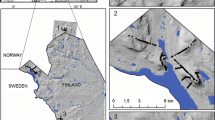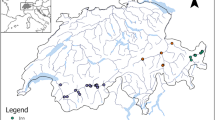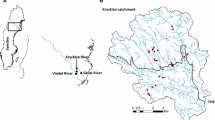Abstract
Biotic interactions are predicted to have the strongest influence on species assemblages in extreme environments. We therefore test the hypothesis that in abiotically-severe beaches plant–plant interactions, specifically facilitation, are important relative to abiotic conditions. This hypothesis is tested by assessing the influence of dominant vascular plant species on the fine-scale occurrence and richness of vascular and cryptogam species using a unique dataset of boreal beaches along the Finnish Baltic Sea, characterized by strong post-glacial land uplift and large environmental gradients. We studied three different levels of vegetation patterns across a broad geographical scale; individual species, functional groups and the entire community. Results showed that dominant vascular species strongly drive species occurrence and richness in dynamic beach environments, with some species having an influence similar to that of key abiotic variables. In contrast to expectations, facilitative effects did not dominate in these harsh environments. Instead, the outcomes of biotic interactions were species-specific, and also differed between vascular and cryptogam species, with the former group most strongly influenced by a pioneer species and the latter by a late succession generalist. Our study highlights the importance of incorporating biotic interaction effects into models of multiple vegetation properties and cautions against overly simplistic generalizations to describe relatively idiosyncratic interaction effects.




Similar content being viewed by others
References
Ahti T, Hämet-Ahti L, Jalas J (1968) Vegetation zones and their sections in northwestern Europe. Ann Bot Fenn 5:169–211
Austin MP, Van Niel KP (2011) Improving species distribution models for climate change studies: variable selection and scale. J Biogeogr 38:1–8
Barbour MG (1992) Life at the leading edge: the beach plant syndrome. In: Seeliger U (ed) Coastal plant communities of Latin America. Academic Press, New York, pp 291–307
Bertness MD, Hacker SD (1994) Physical stress and positive associations among marsh plants. Am Nat 144:363–372
Boulangeat I, Gravel D, Thuiller W (2012) Accounting for dispersal and biotic interactions to disentangle the drivers of species distributions and their abundances. Ecol Lett 15:584–593
Brightmore D, White PHF (1963) Lathyrus japonicus Willd. J Ecol 51:795–801
Britton A, Marrs R, Pakeman R, Carey P (2003) The influence of soil type, drought and nitrogen addition on interactions between Calluna vulgaris and Deschampsia flexuosa: implications for heathland regeneration. Plant Ecol 166:93–105
Brooker RW, Callaghan TV (1998) The balance between positive and negative plant interactions and its relationship to environmental gradients: a model. Oikos 81:196–207
Cavieres LA, Badano EI (2009) Do facilitative interactions increase species richness at the entire community level? J Ecol 97:1181–1191
Davis AJ, Jenkinson LS, Lawton JH, Shorrocks B, Wood S (1998) Making mistakes when predicting shifts in species range in response to global warming. Nature 391:783–786
Dixon FL, Clay DV, Willoughby I (2005) The relative efficacy of herbicides for the control of Deschampsia flexuosa (L.) Trin. in woodland establishment in the UK. Forestry 78:229–238
Doxford SW, Ooi MKJ, Freckleton RP (2013) Spatial and temporal variability in positive and negative plant–bryophyte interactions along a latitudinal gradient. J Ecol 101:465–474
Drebs A, Nordlund A, Karlsson P, Helminen J, Rissanen P (2002) Climatological statistics of Finland 1971–2000. Climatic Statistics of Finland No. 2002:1, Finnish Meteorological Institute, Helsinki
Elith J, Leathwick JR, Hastie T (2008) A working guide to boosted regression trees. J Anim Ecol 77:802–813
Field R, Hawkins BA, Cornell HV et al (2009) Spatial species-richness gradients across scales: a meta-analysis. J Biogeogr 36:132–147
Fielding AH, Bell JF (1997) A review of methods for the assessment of prediction errors in conservation presence/absence models. Environ Conserv 24:38–49
Finnish Meteorological Institute (2011) Sea level observations. http://en.ilmatieteenlaitos.fi/sea-level (Accessed 27 July 2011)
Finnish Meteorological Institute (2012a) Theoretical mean sea level and geodetical leveling systems in Finland. http://en.ilmatieteenlaitos.fi/theoretical-mean-sea-level (Accessed 4 Dec 2012)
Finnish Meteorological Institute (2012b) Terminen kasvukausi. http://ilmatieteenlaitos.fi/terminen-kasvukausi (Accessed 19 Dec 2012)
Forey E, Lortie CJ, Michalet R (2009) Spatial patterns of association at local and regional scales in coastal sand dune communities. J Veg Sci 20:916–925
Franklin J (2009) Mapping species distributions: spatial inference and prediction. Cambridge University Press, Cambridge
Franks SJ, Peterson CJ (2003) Burial disturbance leads to facilitation among coastal dune plants. Plant Ecol 168:13–21
Friedman JH (2001) Greedy function approximation: a gradient boosting machine. Ann Stat 29:1189–1232
Grau O, Rautio P, Heikkinen J, Saravesi K, Kozlov MV, Markkola A (2010) An ericoid shrub plays a dual role in recruiting both pines and their fungal symbionts along primary succession gradients. Oikos 119:1727–1734
Greipsson S, Davy AJ (1994) Leymus arenarius—characteristics and uses of a dune-building grass. Icel Agric Sci 8:41–50
Grime JP, Hodgson JG, Hunt R (2007) Comparative plant ecology: a functional approach to common British species, 2nd edn. Unwin Hyman, London
Gross K (2008) Positive interactions among competitors can produce species-rich communities. Ecol Lett 11:929–936
Hämet-Ahti L, Suominen J, Ulvinen T, Uotila P (eds) (1998) Retkeilykasvio, 4th edn. The Finnish Museum of Natural History, Helsinki
Hellemaa P (1998) The development of coastal dunes and their vegetation in Finland. Fennia 176:111–221
Hjort J, Luoto M (2009) Interaction of geomorphic and ecologic features across altitudinal zones in a subarctic landscape. Geomorphology 112:324–333
Huston M (1979) A general hypothesis of species diversity. Am Nat 113:81–101
Johansson MM, Kahma KK, Boman H, Launiainen J (2004) Scenarios for sea level on the Finnish coast. Boreal Environ Res 9:153–166
Kissling WD, Dormann CF, Groeneveld J et al (2012) Towards novel approaches to modelling biotic interactions in multispecies assemblages at large spatial extents. J Biogeogr 39:2163–2178
Koponen T (2000) Lehtisammalten määritysopas, 4th edn. Helsingin yliopiston kasvitieteen laitoksen monisteita 175, University of Helsinki Department of Botany, Helsinki
le Roux PC, Virtanen R, Heikkinen RK, Luoto M (2012) Biotic interaction affect the elevational ranges of high-latitude plant species. Ecography 35:1048–1056
le Roux PC, Lenoir J, Pellissier L, Wisz MS, Luoto M (2013) Horizontal, but not vertical, biotic interactions affect fine-scale plant distribution patterns in a low energy system. Ecology 94:671–682
Lortie CJ, Brooker RW, Choler P, Kikvidze Z, Michalet R, Pugnaire FI, Callaway RM (2004) Rethinking plant community theory. Oikos 107:433–438
Maestre FT, Callaway RM, Valladares F, Lortie CJ (2009) Refining the stress-gradient hypothesis for competition and facilitation in plant communities. J Ecol 97:119–205
Martínez ML, García-Franco JG (2004) Plant–plant interactions in coastal dunes. In: Martínez ML, Psuty NP (eds) Coastal dunes: ecology and conservation. Springer, Berlin, pp 205–220
Maun MA (2004) Burial of plants as a selective force in sand dunes. In: Martínez ML, Psuty NP (eds) Coastal dunes: ecology and conservation. Springer, Berlin, pp 119–135
Meier ES, Edwards TC Jr, Kienast F, Dobbertin M, Zimmermann NE (2011) Co-occurrence patterns of trees along macro-climatic gradients and their potential influence on the present and future distribution of Fagus sylvatica L. J Biogeogr 38:371–382
Ovaskainen O, Hottola J, Siitonen J (2010) Modeling species co-occurrence by multivariate logistic regression generates new hypotheses on fungal interactions. Ecology 91:2514–2521
Ridgeway G (2013) gbm: generalized boosted regression models. http://cran.r-project.org/web/packages/gbm/index.html (Accessed 15 May 2013)
Ripley BS, Pammenter NW (2004) Physiological characteristics of coastal dune pioneer species from the Eastern Cape, South Africa, in relation to stress and disturbance. In: Martínes ML, Psuty NP (eds) Coastal dunes: ecology and conservation. Springer, Berlin, pp 137–154
Santoro R, Jucker T, Carboni M, Acosta ATR (2012) Patterns of plant community assembly in invaded and non-invaded communities along a natural environmental gradient. J Veg Sci 23:483–494
Stenroos S, Ahti T, Lohtander K, Myllys L (eds) (2011) Suomen jäkäläopas. The Finnish Museum of Natural History, Helsinki
Suominen T, Kalliola R, Tolvanen H (2007) Exposure of the Finnish coasts UTU fetch data 2007. In: Kalliola R, Suominen T (eds) Spatial modelling in coastal areas. Mapping of exposure, sea surface temperature and shore occupation. UTU-LCC Publications 13, University of Turku Department of Geography, Turku, pp 7–16
R Development Core Team (2013) R: a language and environment for statistical computing. R Foundation for Statistical Computing, Vienna. http://www.R-project.org (Accessed 2 March 2013)
Tielbörger K, Kadmon R (2000) Temporal environmental variation tips the balance between facilitation and interference in desert plants. Ecology 81:1544–1553
Wisz MS, Pottier J, Kissling WD et al (2013) The role of biotic interactions in shaping distributions and realised assemblages of species: implications for species distribution modeling. Biol Rev 88:15–30
Zarnetske PL, Skelly DK, Urban MC (2012) Biotic multipliers of climate change. Science 336:1516–1518
Acknowledgments
The research was financially supported by the Research Foundation of the University of Helsinki, the Mathematics and Sciences Fund of the University of Helsinki and Nordeanskiold-samfundet i Finland. Pirjo Hellemaa gave valuable comments during the study and Heidi Alanen assisted in the field.
Author information
Authors and Affiliations
Corresponding author
Appendix
Appendix
Rights and permissions
About this article
Cite this article
Nylén, T., le Roux, P.C. & Luoto, M. Biotic interactions drive species occurrence and richness in dynamic beach environments. Plant Ecol 214, 1455–1466 (2013). https://doi.org/10.1007/s11258-013-0266-y
Received:
Accepted:
Published:
Issue Date:
DOI: https://doi.org/10.1007/s11258-013-0266-y




